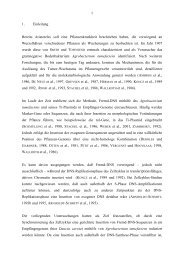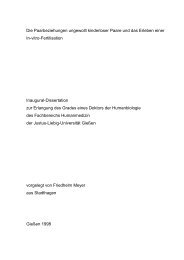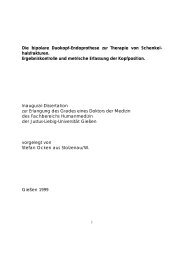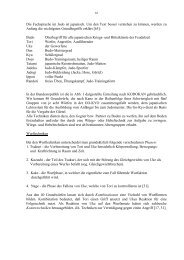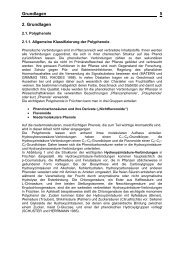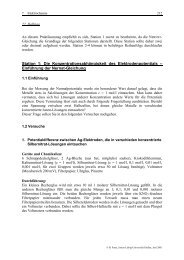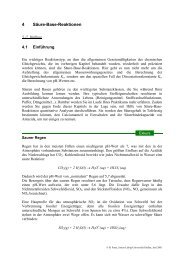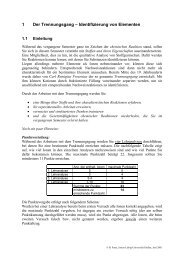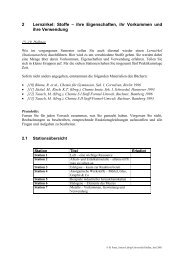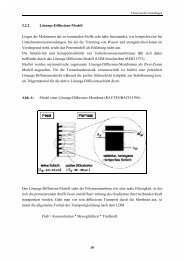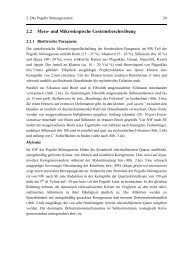Effects of diabaticity on fusion of heavy nuclei in the dinuclear model ...
Effects of diabaticity on fusion of heavy nuclei in the dinuclear model ...
Effects of diabaticity on fusion of heavy nuclei in the dinuclear model ...
Create successful ePaper yourself
Turn your PDF publications into a flip-book with our unique Google optimized e-Paper software.
products. However, <strong>in</strong> <strong>the</strong> driv<strong>in</strong>g potential calculated with <strong>the</strong> phenomenological method <strong>the</strong><br />
peculiarities <str<strong>on</strong>g>of</str<strong>on</strong>g> <strong>the</strong> s<strong>in</strong>gle-particle spectra <str<strong>on</strong>g>of</str<strong>on</strong>g> <strong>the</strong> DNS <strong>nuclei</strong> are not taken <strong>in</strong>to account explicitly.<br />
The shell effects <strong>in</strong> <strong>the</strong> driv<strong>in</strong>g potentials calculated with <strong>the</strong> TCSM-method and <strong>the</strong> alter-<br />
native microscopical method reflect <strong>the</strong> <strong>in</strong>fluence <str<strong>on</strong>g>of</str<strong>on</strong>g> peculiarities <str<strong>on</strong>g>of</str<strong>on</strong>g> <strong>the</strong> s<strong>in</strong>gle-particle spectra<br />
near <strong>the</strong> Fermi surface <strong>on</strong> <strong>the</strong> nucle<strong>on</strong> exchange process. For this reas<strong>on</strong>, <strong>the</strong>se driv<strong>in</strong>g potentials<br />
can carry more <strong>in</strong>formati<strong>on</strong> about <strong>the</strong> DNS evoluti<strong>on</strong> <strong>in</strong> η than <strong>the</strong> driv<strong>in</strong>g potential calculated<br />
with <strong>the</strong> phenomenological method. It is obvious that <strong>the</strong> positi<strong>on</strong> <str<strong>on</strong>g>of</str<strong>on</strong>g> <strong>the</strong> <strong>in</strong>itial c<strong>on</strong>figurati<strong>on</strong><br />
η i def<strong>in</strong>es <strong>the</strong> evoluti<strong>on</strong> directi<strong>on</strong> <str<strong>on</strong>g>of</str<strong>on</strong>g> <strong>the</strong> DNS <strong>in</strong> η. The driv<strong>in</strong>g potentials calculated with <strong>the</strong><br />
TCSM- and with <strong>the</strong> alternative microscopical methods have few local m<strong>in</strong>ima. The absence<br />
<str<strong>on</strong>g>of</str<strong>on</strong>g> local m<strong>in</strong>ima for some magic <strong>nuclei</strong> <strong>in</strong> <strong>the</strong> d<strong>in</strong>uclear system can be expla<strong>in</strong>ed by <strong>the</strong> shell<br />
structure <str<strong>on</strong>g>of</str<strong>on</strong>g> <strong>the</strong> c<strong>on</strong>jugated nucleus and <strong>the</strong> <strong>in</strong>fluence <str<strong>on</strong>g>of</str<strong>on</strong>g> <strong>the</strong> neutr<strong>on</strong> subsystem.<br />
The effect <str<strong>on</strong>g>of</str<strong>on</strong>g> <strong>the</strong> deformati<strong>on</strong>s <str<strong>on</strong>g>of</str<strong>on</strong>g> <strong>the</strong> <strong>nuclei</strong> <strong>on</strong> <strong>the</strong> driv<strong>in</strong>g potential is presented <strong>in</strong> Figs.<br />
4-6b) and 4-7b) for <strong>the</strong> d<strong>in</strong>uclear systems 180 Hg and 246 Fm, respectively. Here, <strong>the</strong> driv<strong>in</strong>g<br />
potential calculated with<strong>in</strong> <strong>the</strong> TCSM and <strong>the</strong> phenomenological potential are shown.We assume<br />
that <strong>the</strong> deformati<strong>on</strong>s take <strong>the</strong> effects <str<strong>on</strong>g>of</str<strong>on</strong>g> polarisati<strong>on</strong> <str<strong>on</strong>g>of</str<strong>on</strong>g> <strong>the</strong> nucleus <strong>in</strong>duced by <strong>the</strong> mean-field<br />
<str<strong>on</strong>g>of</str<strong>on</strong>g> <strong>the</strong> o<strong>the</strong>r nucleus <strong>in</strong>to account. The potential energy <str<strong>on</strong>g>of</str<strong>on</strong>g> <strong>the</strong> DNS with prolate <strong>nuclei</strong> is<br />
smaller than <strong>the</strong> potential energy with spherical <strong>nuclei</strong> (Figs. 4-6a) and 4-7a) ) because <strong>the</strong><br />
Coulomb energy becomes larger for spherical <strong>nuclei</strong>. In this case, <strong>the</strong> fusi<strong>on</strong> barrier <strong>in</strong> η gets<br />
smaller than <strong>the</strong> <strong>on</strong>e obta<strong>in</strong>ed with spherical <strong>nuclei</strong>. For oblate deformati<strong>on</strong>s <str<strong>on</strong>g>of</str<strong>on</strong>g> <strong>the</strong> <strong>nuclei</strong>,<br />
<strong>the</strong> potential energy and <strong>the</strong> fusi<strong>on</strong> barrier <strong>in</strong> η are larger than for spherical <strong>nuclei</strong>. In reality,<br />
some averag<strong>in</strong>g over <strong>the</strong> orientati<strong>on</strong>s <str<strong>on</strong>g>of</str<strong>on</strong>g> <strong>the</strong> <strong>nuclei</strong> has to be carried out <strong>in</strong> <strong>the</strong> <strong>in</strong>itial DNS.<br />
The deformati<strong>on</strong> effects produce fluctuati<strong>on</strong>s <str<strong>on</strong>g>of</str<strong>on</strong>g> <strong>the</strong> value <str<strong>on</strong>g>of</str<strong>on</strong>g> <strong>the</strong> fusi<strong>on</strong> barrier <strong>in</strong> η around <strong>the</strong><br />
value obta<strong>in</strong>ed for spherical <strong>nuclei</strong>. In <strong>the</strong> present versi<strong>on</strong> <str<strong>on</strong>g>of</str<strong>on</strong>g> <strong>the</strong> TCSM, <strong>the</strong> <strong>in</strong>tr<strong>in</strong>sic symmetry<br />
axes <str<strong>on</strong>g>of</str<strong>on</strong>g> <strong>the</strong> deformed <strong>nuclei</strong> lie al<strong>on</strong>g <strong>the</strong> <strong>in</strong>ternuclear axis. For arbitrary orientati<strong>on</strong>s <str<strong>on</strong>g>of</str<strong>on</strong>g> <strong>the</strong><br />
<strong>in</strong>tr<strong>in</strong>sic symmetry axes <str<strong>on</strong>g>of</str<strong>on</strong>g> <strong>the</strong> deformed <strong>nuclei</strong>, a more general TCSM [81] should be used.<br />
Calculati<strong>on</strong>s with <strong>the</strong> method suggested <strong>in</strong> [65] reveal a weak dependence <str<strong>on</strong>g>of</str<strong>on</strong>g> <strong>the</strong> potential <strong>on</strong><br />
<strong>the</strong> orientati<strong>on</strong>s <str<strong>on</strong>g>of</str<strong>on</strong>g> <strong>the</strong> <strong>nuclei</strong>. In order to completely take <strong>in</strong>to account <strong>the</strong> deformati<strong>on</strong> effect <strong>in</strong><br />
<strong>the</strong> driv<strong>in</strong>g potential calculated with <strong>the</strong> alternative microscopical method, <strong>the</strong> s<strong>in</strong>gle-particle<br />
levels should be taken for deformed <strong>nuclei</strong>. For <strong>the</strong> sake <str<strong>on</strong>g>of</str<strong>on</strong>g> simplicity, we use <strong>the</strong> s<strong>in</strong>gle-particle<br />
levels <str<strong>on</strong>g>of</str<strong>on</strong>g> spherical <strong>nuclei</strong> <strong>in</strong> <strong>the</strong> present calculati<strong>on</strong>s. However, <strong>the</strong> fit <str<strong>on</strong>g>of</str<strong>on</strong>g> <strong>the</strong> Fermi surface by <strong>the</strong><br />
53



